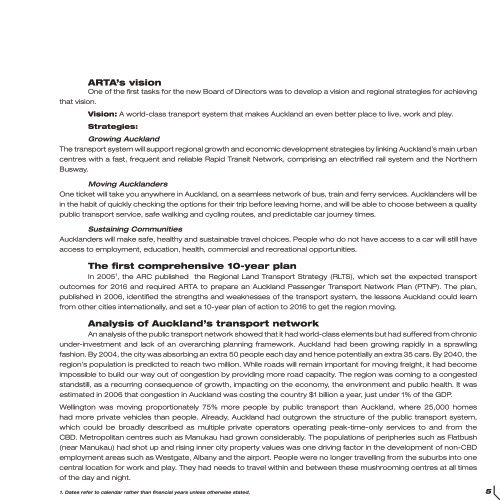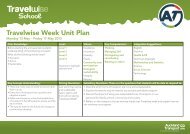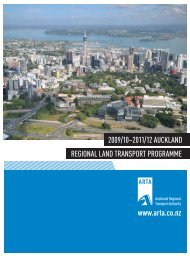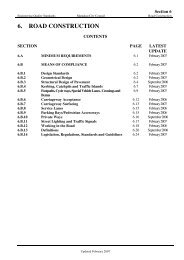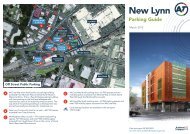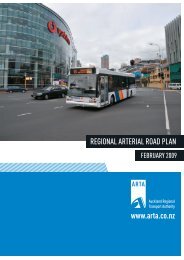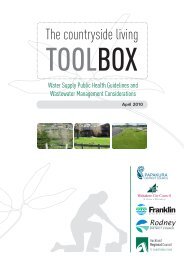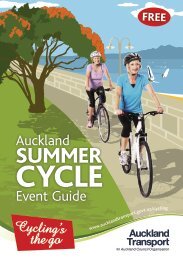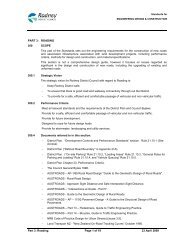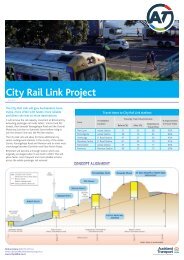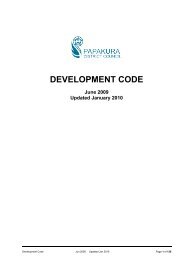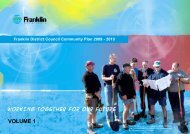The ARTA Years 2004 â 2010 - Auckland Transport
The ARTA Years 2004 â 2010 - Auckland Transport
The ARTA Years 2004 â 2010 - Auckland Transport
Create successful ePaper yourself
Turn your PDF publications into a flip-book with our unique Google optimized e-Paper software.
<strong>ARTA</strong>’s vision<br />
One of the first tasks for the new Board of Directors was to develop a vision and regional strategies for achieving<br />
that vision.<br />
Vision: A world-class transport system that makes <strong>Auckland</strong> an even better place to live, work and play.<br />
Strategies:<br />
Growing <strong>Auckland</strong><br />
<strong>The</strong> transport system will support regional growth and economic development strategies by linking <strong>Auckland</strong>’s main urban<br />
centres with a fast, frequent and reliable Rapid Transit Network, comprising an electrified rail system and the Northern<br />
Busway.<br />
Moving <strong>Auckland</strong>ers<br />
One ticket will take you anywhere in <strong>Auckland</strong>, on a seamless network of bus, train and ferry services. <strong>Auckland</strong>ers will be<br />
in the habit of quickly checking the options for their trip before leaving home, and will be able to choose between a quality<br />
public transport service, safe walking and cycling routes, and predictable car journey times.<br />
Sustaining Communities<br />
<strong>Auckland</strong>ers will make safe, healthy and sustainable travel choices. People who do not have access to a car will still have<br />
access to employment, education, health, commercial and recreational opportunities.<br />
<strong>The</strong> first comprehensive 10-year plan<br />
In 2005 1 , the ARC published the Regional Land <strong>Transport</strong> Strategy (RLTS), which set the expected transport<br />
outcomes for 2016 and required <strong>ARTA</strong> to prepare an <strong>Auckland</strong> Passenger <strong>Transport</strong> Network Plan (PTNP). <strong>The</strong> plan,<br />
published in 2006, identified the strengths and weaknesses of the transport system, the lessons <strong>Auckland</strong> could learn<br />
from other cities internationally, and set a 10-year plan of action to 2016 to get the region moving.<br />
Analysis of <strong>Auckland</strong>’s transport network<br />
An analysis of the public transport network showed that it had world-class elements but had suffered from chronic<br />
under-investment and lack of an overarching planning framework. <strong>Auckland</strong> had been growing rapidly in a sprawling<br />
fashion. By <strong>2004</strong>, the city was absorbing an extra 50 people each day and hence potentially an extra 35 cars. By 2040, the<br />
region’s population is predicted to reach two million. While roads will remain important for moving freight, it had become<br />
impossible to build our way out of congestion by providing more road capacity. <strong>The</strong> region was coming to a congested<br />
standstill, as a recurring consequence of growth, impacting on the economy, the environment and public health. It was<br />
estimated in 2006 that congestion in <strong>Auckland</strong> was costing the country $1 billion a year, just under 1% of the GDP.<br />
Wellington was moving proportionately 75% more people by public transport than <strong>Auckland</strong>, where 25,000 homes<br />
had more private vehicles than people. Already, <strong>Auckland</strong> had outgrown the structure of the public transport system,<br />
which could be broadly described as multiple private operators operating peak-time-only services to and from the<br />
CBD. Metropolitan centres such as Manukau had grown considerably. <strong>The</strong> populations of peripheries such as Flatbush<br />
(near Manukau) had shot up and rising inner city property values was one driving factor in the development of non-CBD<br />
employment areas such as Westgate, Albany and the airport. People were no longer travelling from the suburbs into one<br />
central location for work and play. <strong>The</strong>y had needs to travel within and between these mushrooming centres at all times<br />
of the day and night.<br />
1. Dates refer to calendar rather than financial years unless otherwise stated.<br />
5


